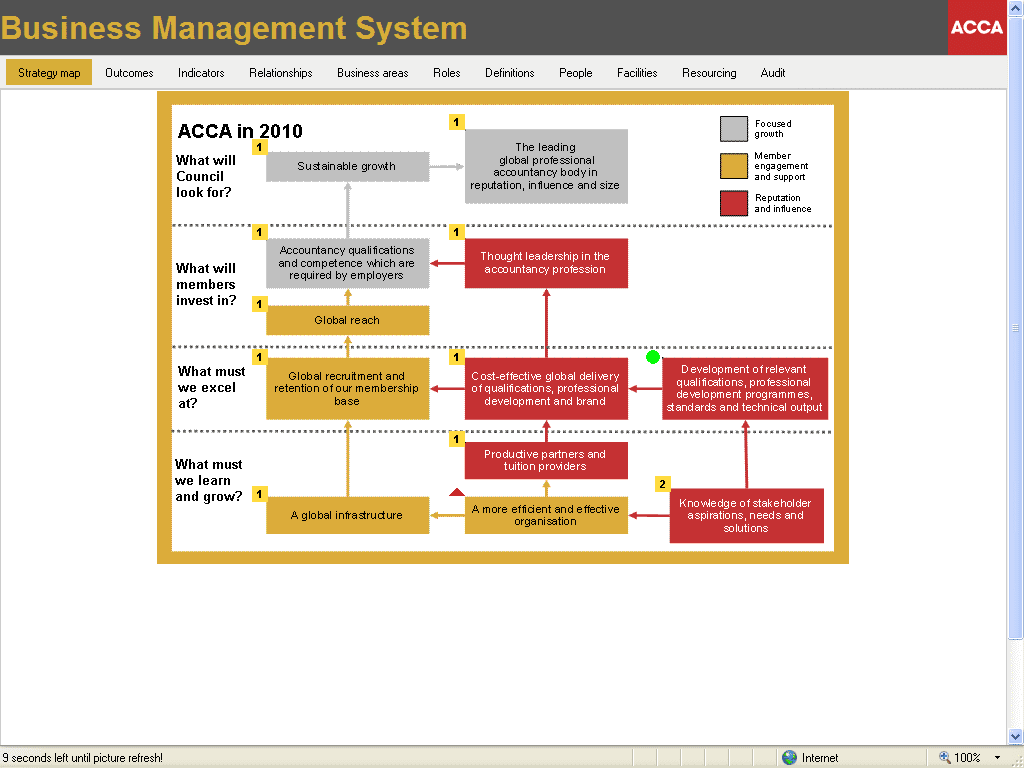Neville de Spretter, former Head of Internal Audit at ACCA, describes a new approach being used by ACCA to grasp the holy grail of prevention rather than cure.
INTEGRITY THROUGH INTEGRATION
On 5 October 2005, ACCA’s Senior Management Group (SMG) met at the Waldorf Hotel to review ACCA’s performance over the last year and to set targets for the next year. There was much debate about the past and future key performance indicators and a general feeling emerged that there had to be a better way to lead and manage the organisation.
At the time, the strategic imperatives, initiatives and KPIs were unlinked, disconnected from what actually happens in the business, and had little apparent commitment from staff. Much depended on the attention of the Chief Executive, who knew he needed a robust, efficient and effective management framework and system but rightly dislikes bureaucracy and transfer charging.
In the afternoon a consultant, Peter Bebb of Perendie, presented a strategy map similar to the following:

The SMG, led by Chief Executive Allen Blewitt, immediately saw that the strategy map had summarised ACCA’s 35 page strategy into the 12 outcomes which are most critical to the realisation of its vision. It had also defined the causal relationships between the outcomes, i.e. which outcomes are dependent on which other outcomes. In so doing, it had validated and assured the quality of the strategy.
The SMG also recognised a solution to the age-old problem of prioritisation. Outcomes are prioritised by their inclusion on the strategy map, and actions are prioritised by their relationship to the strategic outcomes. Those actions which directly deliver the strategic outcomes are automatically top priority. Not all actions result in something useful and hard work is not always productive. Relating actions to the strategic outcomes ensures that only useful actions are included.
The SMG also saw that the cause and effect relationships between outcomes provide a means of predicting the delivery of the vision. If one of the prime causes is failing, there is early warning that the vision is at risk of failure. KPIs do not provide this predictability.
The Chief Executive immediately set up a Strategy Implementation Team (SIT) consisting of myself, Peter Bebb, the Head of Strategy Implementation and the Risk Manager, sponsored by himself and led by the Managing Director Operations.
Effective communication of the strategy is a necessary condition of its implementation. The strategy map tells the story of the strategy without additional explanation. It explains how the strategy will be delivered. It is possible, by following the arrows, to understand the chain of cause and effect which will lead to the ultimate outcome which achieves the mission.
A strategy map is simple. It fits onto one page. It provides unexpected insights into the future of the organisation. The outcomes on a strategy map are concrete, specific and measurable. The causal connections between the outcomes give credibility to the story it tells. And the combination of these factors creates understanding of the strategy and gets people on board.
The SMG discussed, amended and agreed the strategy map with Council, ACCA’s governing body. The Chief Executive communicated the strategy map to ACCA’s staff.
In consequence, many more people understand ACCA’s strategy, and there is consensus on what needs to be delivered strategically.
While the strategy map was being communicated, the SIT started to develop a balanced scorecard to measure and predict the delivery of the strategic outcomes. The balanced scorecard differs from key performance indicators (KPIs). There is a unique measure of the achievement of an outcome which avoids the ambiguity caused by multiple KPIs. There is also a predictor measure, which tells the management team whether they are likely to achieve the outcome. Finally the SIT identified the key risk to each outcome, aligning risks with outcomes.
We discussed and modified the balanced scorecard with the project sponsor, the project leader, the SMG and Council. The Remuneration Committee has agreed that the SMG’s bonuses are determined by the achievement of the strategic outcomes as measured by the balanced scorecard.
Much clarity, objectivity and productivity has been obtained through the strategy map and the balanced scorecard.
Of course it’s not enough to know what you need to achieve. You also have to achieve it.
The SIT next worked out what ACCA needs to do to achieve its strategic outcomes. We deliberately ignored current processes and project in order to get an objective view of what is really necessary, in line with Michael Hammer’s original principle of Business Process Re-engineering. We then compared these with current processes and initiatives to identify those which could stop.
The relationships between the outcomes and the activities required to deliver them have defined outcome-oriented organisational units and teams which successively add value to the stakeholders of ACCA by delivering the strategic outcomes. The skills required by the teams are defined as the ability to carry out the activities needed to deliver the outcomes, and the competences are defined as the ability to produce the outcomes.

Outcome-oriented teams are more productive than skill-based teams such as Marketing or Human Resources Departments because they focus people on the delivery of outcomes rather than operation within a skill silo.
The value chain was discussed, amended and agreed with the SMG. Following this agreement, the SIT derived a service-oriented architecture from the value chain which revealed that the existing portfolio of around 60 ACCA computer systems and fragmented data store could be reduced to just 5 systems and 2 databases, saving million of pounds whilst dramatically improving the service provided to staff and members.
The final step in the alignment of ACCA corporately was to estimate the resources required – the skills and facilities required to carry out the activities. The volume of skills required was calculated from an estimate the time needed to carry out each activity multiplied by the number of outcomes to be delivered. This resource optimisation process identified a potential productivity g ain of 20%.
The SIT next broke the strategic outcomes, activities and resources into their contributory outcomes, activities and resources. We formed lower level business areas from these and agreed them with the SMG, who then formed business area teams to define the areas in more detail.
Successive levels of the existing organisational structure will be invited to say what they can contribute to higher level outcomes. In defining their own contributions, people declare their accountability and responsibility for the delivery of these outcomes. This ‘pull’ approach will create genuinely self-managing teams.
We are producing a lot of information and need somewhere to store it and process it so that we can use it to lead, manage and audit the business. Perendie are developing a business management system for us, which will provide the following benefits:
Integration – everything the organisation needs to do and employ to deliver its required outcomes will be linked at all levels across the whole value chain from customers through staff to suppliers
Predictability – the probability of the required outcomes being delivered will be objectively predicted, enabling risk mitigation
Transparency – any stakeholder will be able to see what ACCA intends to employ, do and deliver, and the progress being made and expected.

We’re talking about changing the whole business management process – about integrating and replacing existing management processes, including corporate governance, business planning, budgeting, risk management, resource management, portfolio and programme management, performance management, reward management, information technology strategy, knowledge management and corporate communication. It is wrong to see business alignment as a programme or project. It is simply a more economic, efficient and effective way of running an organisation. It firstly transforms the organisation and then continuously improves it.
Consequently this isn’t a quick fix though there are quick wins along the way, as described above. But it hasn’t been plain-sailing. As you can see the timescale is longer than anyone would like, but forcing the pace doesn’t work with a programme that is aimed at creating self-managing teams. The main reason for the long timescale is the distraction of the daily crises which business alignment will prevent.
Perendie also had problems producing the business management system. Their first supplier failed to deliver the system required. Perendie appointed a more flexible and productive supplier, and are delighted with the quality of the system they have produced.
I am keen for others to benefit as we have and will be happy to show you what we’ve done. I can be contacted at [email protected].






